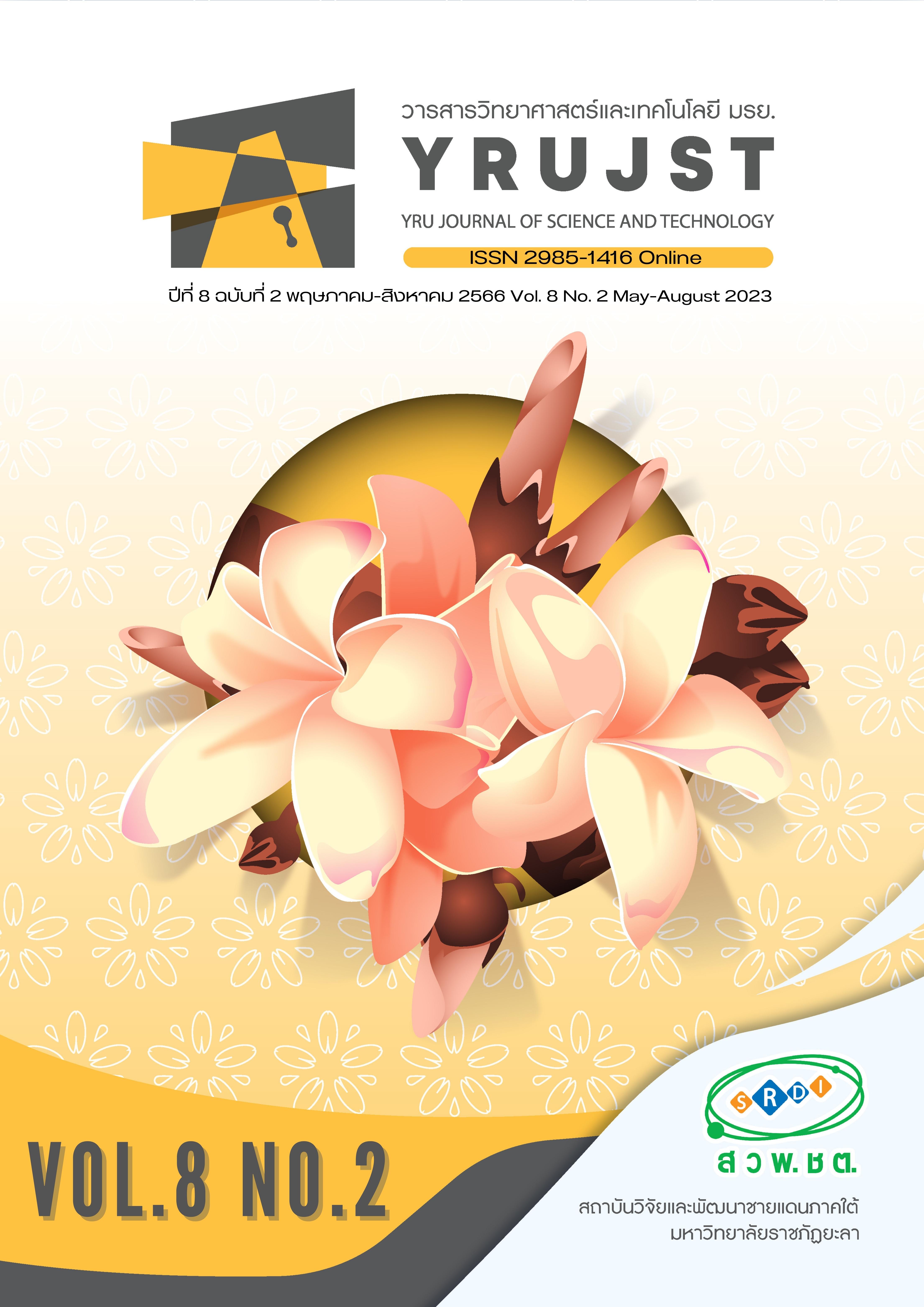การวิเคราะห์ปริมาณสารประกอบฟีนอลิกทั้งหมดและฤทธิ์ต้านอนุมูลอิสระของดอกไม้ 6 ชนิด และการพัฒนาโลชั่นบำรุงผิวผสมสารสกัดจากดอกหางนกยูง
Main Article Content
บทคัดย่อ
รงควัตถุที่พบในดอกไม้เต็มไปด้วยสารออกฤทธิ์ทางชีวภาพที่หลากหลาย โดยเฉพาะฤทธิ์ในการต้านอนุมูลอิสระซึ่งเป็นคุณสมบัติที่ดีต่อผิวพรรณ การนำดอกไม้มาแปรรูปเป็นผลิตภัณฑ์เครื่องสำอางสำหรับบำรุงผิวจึงเป็นทางเลือกหนึ่งที่น่าสนใจสําหรับผู้บริโภค งานวิจัยครั้งนี้ได้ศึกษาปริมาณสารประกอบฟีนอลิกทั้งหมดด้วยวิธี Folin-Ciocalteu และศึกษาฤทธิ์ต้านอนุมูลอิสระด้วยวิธี DPPH radical scavenging ability ของสารสกัดไม้ดอกด้วยเอทานอลจำนวน 6 ชนิด ได้แก่ ดอกเข็ม ดอกหางนกยูง ดอกเฟื่องฟ้า ดอกดาหลา ดอกบานบุรี และดอกราชพฤกษ์ เพื่อพัฒนาสูตรตำรับโลชั่นบำรุงผิวด้วยสารสกัดจากดอกไม้ที่มีฤทธิ์ต้านอนุมูลอิสระ พบว่าดอกหางนกยูงมีปริมาณสารประกอบฟีนอลิกสูงสุดเท่ากับ 432.85 mg GAE/g extract และมีฤทธิ์การยับยั้งอนุมูลอิสระสูงสุดเท่ากับร้อยละ 85.19 ที่ความเข้มข้น 50 มิลลิกรัม/มิลลิลิตร ผลการทดสอบคุณลักษณะของโลชั่นต้นตำรับจากสารสกัดดอกหางนกยูงพบว่ามีค่า pH 6.4 เนื้อครีมมีความคงตัวที่เหมาะสม ไม่แยกชั้นตามมาตรฐานอุตสหกรรมเอส ผลิตภัณฑ์โลชั่นบำรุงผิวผสมสมุนไพร กระทรวงอุตสาหกรรม (มอก. เอส 15-2561) จากข้างต้นสรุปได้ว่าดอกหางนกยูงมีประสิทธิภาพในการกําจัดอนุมูลอิสระได้ดีมีความเหมาะสมในการนําไปพัฒนาเป็นโลชั่นบำรุงผิว ที่เป็นการเพิ่มมูลค่าและยกระดับสู่การผลิตเป็นผลิตภัณฑ์ชุมชนต่อไป
Article Details

อนุญาตภายใต้เงื่อนไข Creative Commons Attribution-NonCommercial-NoDerivatives 4.0 International License.
บทความ ข้อมูล เนื้อหา รูปภาพ ฯลฯ ที่ได้รับการเผยแพร่ในวารสารวิทยาศาสตร์และเทคโนโลยี มรย. นี้ ถือเป็นลิขสิทธิ์ของวารสารวิทยาศาสตร์และเทคโนโลยี มรย. หากบุคคลหรือหน่วยงานใดต้องการนำทั้งหมดหรือส่วนหนึ่งส่วนใดไปเผยแพร่ต่อหรือกระทำการใดๆ จะต้องได้รับอนุญาตเป็นลายลักษณ์อักษรจากวารสารวิทยาศาสตร์และเทคโนโลยี มรย. ก่อนเท่านั้น
เอกสารอ้างอิง
Buachoon, N. & Manjit, W. (2018). Quantitation of total phenolic antioxidant activity and development of skin care lotion. VRU Research and Development Journal Science and Technology, 3(2), 86-97.
Buachoon, N. & Ngamnon, Y. (2021). Development of skin lotion from Albizia myriophylla Benth. and Ardisia Elliptica Thumb. cured extracts. VRU Research and Development Journal Science and Technology, 3(2), 74-85.
Duangjit, S., Suwannarat, K., Kittiphinitnunta, K., Ongwisut, P., Bumrungthai, S., Ngawhirunpat, T. Charoenputtakun, P. & Sila-On, W. (2019). Role of nature antioxidants for topical applications: properties, Efficacy, safety and novel delivery systems. Isan Journal of Pharmaceutical Sciences, 15(1), 21-48.
Gulcin, İ. (2020). Antioxidants and antioxidant methods: An updated overview. Archives of Toxicology, 94(3), 651–715.
Halee, A. & Rattanapun, B. (2017). Study of antiox idant efficacies of 15 local herbs. KMUTT Research and Development Journal, 40(2), 283-293.
Harnvanich, E. A., Wanichwecharungruang, S., Chandrachai, A. & Asawanonda, P. (2020). Market Potential Evaluation for Local Herbal Extracts Used in Skincare Through the New Product Development Process. PSAKU International Journal of Interdisciplinary Research, 9(2), 31-40.
Kumari, P., & Bhargava, B. (2021). Phytochemicals from edible flowers: Opening a new arena for healthy lifestyle. Journal of Functional Foods, 78, 104375.
Leelapornpisid, P., Muangmai, L., Sirithunyalug, B. Jiranusornkul, S. & Peerapornpisal, Y. (2014). A novel moisturizer extracted from fresh water macroalga [Rhizoclonium hieroglyphicum (C. Agardh) Kutzing] for skin care cosmetic. Chiang Mai Journal of Science, 41(5.2), 1195-1207.
Luximon-Ramma, A., Bahorun, T., Soobrattee, A. M., & Aruoma, I.O. (2002). Antioxidant Activities of Phenolic, Proanthocyanidin, and Flavonoid Components in Extracts of Cassia fistula. J. Agric. Food Chem, 50, 5042-5047.
Mahmood, T., Anwar, F., Abbas, M. & Saari, N. (2012). Effect of maturity on phenolics (phenolic acids and flavonoids) profile of strawberry cultivars and mulberry species from Pakistan. International Journal of Molecular Sciences, 13(4), 4591–4607.
Maneechai, S. & Rinthong, P. (2017). Total phenolic contents and antioxidant activity from ethanolic Bauhinia Purpurea, Clitoria Ternatea, Ixora Coccinea and Calliandra Haematocephala flower extracts. Journal of Science and Technology Mahasarakham University, 36(2), 148-153.
Morais, J. S., Sant'Ana, A. S., Dantas, A. M., Silva, B. S., Lima, M. S., Borges, G. C., & Magnani, M. (2020). Antioxidant activity and bioaccessibility of phenolic compounds in white, red, blue, purple, yellow and orange edible flowers through a simulated intestinal barrier. Food Research International, 131, 109046.
Nimse, S. B. & Pal, D. (2015). Free radicals, natural antioxidants, and their reaction mechanisms. RSC Advances, 5(35), 27986–28006.
Noreen, H., Semmar, N., Farman, M., & McCullagh, J. S. (2017). Measurement of total phenolic content and antioxidant activity of aerial parts of medicinal plant Coronopus didymus. Asian Pacific Journal of Tropical Medicine, 10(8), 792-801.
Ounamornmas, P., & Sommano, S. (2016). Analyses of bioactive ingredients and antioxidant activites of some edible flowers. Journal of Agriculture, 32(3), 435-445.
Rahim, N. A., Roslan, M. N. F., Muhamad, M. & Seeni, A. (2022). Antioxidant activity, total phenolic and flavonoid content and LC–MS profiling of leaves extracts of Alstonia angustiloba. Separations, 9(9), 234.
Rattana, S. & Sungthong, B. (2016). Antioxidant activities and total phenolic contents of methanolic extract from five fragrant flowers, The 12th Mahasarakham University Research Conference, 8-9 September, 2016. Mahasarakham: Mahasarakham University.
Siritrakulsak, P., Chutichudet, P., Chutichudet, B., Plainsirichai, M. & Boontiang, K. (2013). Antioxidant activity of fifteen edible flowers in Maha Sarakham province. Khon Kaen Agriculture Journal, 41, 607-11.
Youwei, Z., Jinlian, Z., & Yonghong, P. (2008). A comparative study on the free radical scavenging activities of some fresh flowers in southern China. LWT-Food Science and Technology, 41, 1586-1591.


